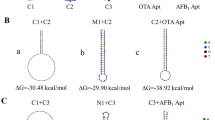Abstract
We explored a fluorescent strategy for sensing ochratoxin A (OTA) by using a single fluorophore-labeled aptamer for detection of OTA. This method relied on the change of the fluorescence intensity of the labeled dye induced by the specific binding of the fluorescent aptamer to OTA. Different fluorescein labeling sites of aptamers were screened, including the internal thymine bases, 3′-end, and 5′-end of the aptamer, and the effect of the labeling on the aptamer affinity was investigated. Some fluorophore-labeled aptamers showed a signal-on or signal-off response. With the fluorescent aptamer switch, simple, rapid, and selective sensing of OTA at nanomolar concentrations was achieved. OTA spiked in diluted red wine could be detected, showing the feasibility of the fluorescent aptamer for a complex matrix. This method shows potential for designing aptamer sensors for other targets.

A simple fluorescent approach for OTA sensing is achieved by using single fluorophore-labeled aptamer. A fluorophore is attached on one site of the aptamer. The affinity binding of OTA induces the alteration of fluorescence properties of the labeled fluorophore as the consequence of the conformation change of the aptamer. OTA can be detected by measuring the change of fluorescence signals of the labeled dye





Similar content being viewed by others
References
Klussmann S (ed) (2006) The aptamer handbook, functional oligonucleotides and their applications. Wiley, Weinheim
Li Y, Lu Y (2009) Functional nucleic acids for analytical applications. Springer, New York
Liu J, Cao Z, Lu Y (2009) Chem Rev 109:1948–1998
Cho EJ, Lee JW, Ellington AD (2009) Annu Rev Anal Chem 2:241–264
Jhaveri SD, Kirby R, Conrad R, Maglott EJ, Bowser M, Kennedy RT, Glick G, Ellington AD (2000) J Am Chem Soc 122:2469–2473
Nutiu R, Li Y (2004) Chem Eur J 10:1868–1876
Juskowiak B (2011) Anal Bioanal Chem 399:3157–3176
Lubin AA, Plaxco KW (2010) Acc Chem Res 43:496–505
Gokulrangan G, Unruh JR, Holub DF (2005) Anal Chem 77:1963–1970
Heyduk E, Heyduk T (2005) Anal Chem 77:1147–1156
Zhu Z, Yang R, You M, Zhang X, Wu Y, Tan W (2010) Anal Bioanal Chem 396:73–83
Ruta J, Perrier S, Ravelet C, Fize J, Peyrin E (2009) Anal Chem 81:7468–7473
Chang H, Tang L, Wang Y, Jiang J, Li J (2010) Anal Chem 82:2341–2346
Wang W, Chen C, Qian M, Zhao XS (2008) Anal Biochem 373:213–219
Zhang D, Lu M, Wang H (2011) J Am Chem Soc 133:9188–9191
Katilius E, Katiliene Z, Woodbury NW (2006) Anal Chem 78:6484–6489
Patel M, Dutta A, Huang H (2011) Anal Bioanal Chem 400:3035–3040
Zhu Z, Ravelet C, Perrier S, Guieu V, Fiore E, Peyrin E (2012) Anal Chem 84:7203–7211
Monaci L, Palmisano F (2004) Anal Bioanal Chem 378:96–103
Hayat A, Paniel N, Rhouati A, Marty JL, Barthelmebs L (2012) Food Control 26:401–415
Cruz-Aguado JA, Penner G (2008) J Agric Food Chem 56:10456–10461
Cruz-Aguado JA, Penner G (2008) Anal Chem 80:8853–8855
Geng X, Zhang D, Wang H, Zhao Q (2013) Anal Bioanal Chem 405:2443–2449
Kuang H, Chen W, Xu D, Xu L, Zhu Y, Liu L, Chu H, Peng C, Xu C, Zhu S (2010) Biosens Bioelectron 76:710–716
Wang L, Ma W, Chen W, Liu L, Ma W, Zhu Y, Xu L, Kuang H, Xu C (2011) Biosens Bioelectron 26:3059–3062
Bone L, Vidal JC, Duato P, Castillo JR (2011) Biosens Bioelectron 26:3254–3259
Barthelmebs L, Jonca J, Hayat A, Prieto-Simon B, Marty J-L (2011) Food Control 22:737–743
Wang L, Chen W, Ma W, Liu L, Ma W, Zhao Y, Zhu Y, Xu L, Kuang H, Xu C (2011) Chem Commun 47:1574–1576
Sheng L, Ren J, Miao Y, Wang J, Wang E (2011) Biosens Bioelectron 26:3494–3499
Girolamo AD, McKeague M, Miller JD, DeRosa MC, Visconti A (2011) Food Chem 127:1378–1384
Rhouati A, Paniel N, Meraihi Z, Marty JL (2011) Food Control 22:1790–1796
Chapuis-Hugon F, du Boisbaudry A, Madru B, Pichon V (2011) Anal Bioanal Chem 400:1199–1207
Yang C, Wang Y, Marty JL, Yang XR (2011) Biosen Bioelectron 26:2724–2727
Tong P, Zhao WW, Zhang L, Xu JJ, Chen HY (2012) Biosens Bioelectron 33:146–151
Wu S, Duan N, Ma X, Xia Y, Wang H, Wang Z, Zhang Q (2012) Anal Chem 84:6263–6270
De Girolamo A, Le L, Penner G, Schena R, Visconti A (2012) Anal Bioanal Chem 403:2627–2634
Yang XH, Kong WJ, Yang MH, Zhao M, Ouyang Z (2013) Chin J Anal Chem 41:297–306
Guo ZJ, Ren JT, Wang JH, Wang EK (2011) Talanta 85:2517–2521
Tessini C, Mardones C, von Baer D, Vega M, Herlitz E, Saelzer R, Silva J, Torres O (2010) Anal Chim Acta 660:119–126
Acknowledgments
This work was supported by grants from the National Natural Science Foundation of China (grant No. 21222503), the State Key Laboratory of Environmental Chemistry and Ecotoxicology in the Research Center for Eco-Environmental Sciences of the Chinese Academy of Sciences (grant No. KF2010-24), and the Key Project of Chinese Ministry of Education (grant No. 212020).
Author information
Authors and Affiliations
Corresponding author
Electronic supplementary material
Below is the link to the electronic supplementary material.
ESM 1
(PDF 262 kb)
Rights and permissions
About this article
Cite this article
Zhao, Q., Geng, X. & Wang, H. Fluorescent sensing ochratoxin A with single fluorophore-labeled aptamer. Anal Bioanal Chem 405, 6281–6286 (2013). https://doi.org/10.1007/s00216-013-7047-2
Received:
Revised:
Accepted:
Published:
Issue Date:
DOI: https://doi.org/10.1007/s00216-013-7047-2




